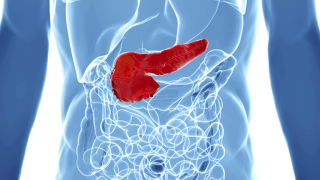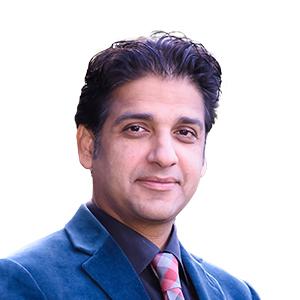The missing puzzle piece to improve outcomes for pancreatic cancer may very well be the ability to identify tumors early. The disease typically spreads to other organs before symptoms arise. As a result, surgery — currently the most successful approach for treating pancreatic cancer — is only applicable for 1 in 5 patients.
If science can develop a way to catch malignant tumors of the pancreas before people experience problems, such as abdominal pain, and before cancer cells have colonized other areas of the body, society may see gains against pancreatic cancer.
This is exactly the vision of City of Hope’s Syed Rahmanuddin, M.B.B.S., M.B.A., assistant research professor of diagnostic radiology and head of the 3D Oncologic Imaging Center.
“Early detection is key,” he said. “We are working on creating the mammogram for pancreatic cancer.”
That endeavor gained added momentum with a publication in the Sept. 8, 2021, edition of Frontiers of Oncology. Rahmanuddin and Daniel Von Hoff, M.D., a distinguished professor at the Translational Genomics Research Institute (TGen), an affiliate of City of Hope, led a study demonstrating the ability to predict the aggressiveness of pancreatic adenocarcinoma, the most common type of pancreatic cancer.
The study evaluated radiologic images from 28 participants comprising patients at City of Hope and participants in a clinical trial at Scottsdale, Arizona’s Honor Health. The research team, which included investigators from Honor Health, MD Anderson Cancer Center and Massachusetts General Hospital, looked at images taken with CAT scans, which produce three-dimensional X-ray images.
More specifically, Rahmanuddin and his colleagues used perfusion imaging, a technique in which people are injected with a contrast agent that makes blood highly visible to the scan, and multiple images are taken over time. This is helpful for pinpointing fast-dividing cancer cells — which require more of the oxygen carried in the blood compared to other types of cells.
For pancreatic cancer, this type of multiphase imaging aims to capture key stages as the blood being tracked moves through a patient’s system, from the heart to the arteries to the veins to the liver. In this study, the research team was specifically focused on the arterial phase and the venous phase.
Images were analyzed using artificial intelligence and a physics-based mathematical tool called the Marley equation, devised by Rahmanuddin and named in honor of the Kemper and Ethel Marley Foundation, which has funded some of his other research.
When the investigators plotted blood flow in what they call a time-intensity-density curve, they found an important correlation: Their method accurately predicted how long the blood being imaged stayed in the venous phase, and a longer venous phase — an indication that there are more cancer cells feasting on oxygen from blood — indicated a more aggressive cancer.
“We believe these findings show that our unique approach of looking at the venous phase could allow us to detect pancreatic cancer in the earliest stage,” Rahmanuddin said.
He and his colleagues plan to validate this approach in a larger study population. They also hope to tie the delayed blood perfusion to an excess of VEGF, a protein that cancer cells use to prompt the growth of new veins to feed them (and another possible marker for pancreatic cancer).
With success, the ultimate goal is to roll this testing procedure out to patients at high risk for pancreatic cancer — with factors such as the presence of diabetes, obesity and a family history of the disease, as well as lifestyle variables including smoking tobacco, a high-fat diet and alcohol use. In these cases, a time-intensity-density curve indicating a significantly prolonged venous phase could help screen for those with early-stage disease.
“Too many people who are diagnosed with pancreatic cancer have limited options for therapies to help them survive longer,” Rahmanuddin said. “We need to figure out exactly how we can diagnose patients earlier. My whole focus is coming up with that test as soon as possible.”

